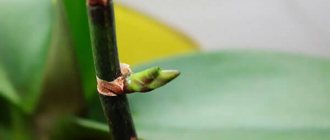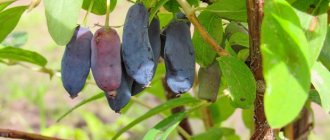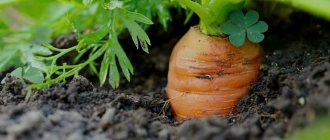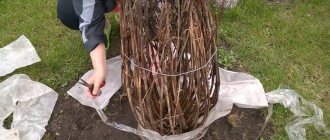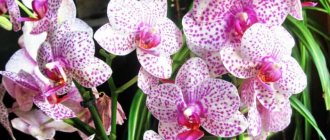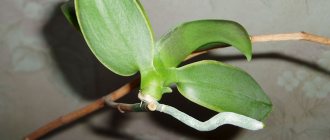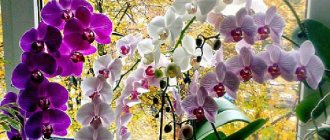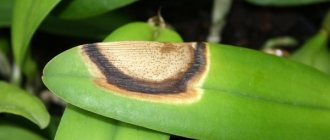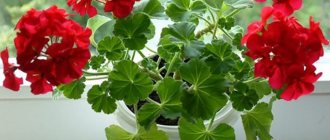Choosing fertilizer for orchids is difficult and at the same time easy. If the owner of a decorative exotic plant knows exactly the characteristics of growing, caring for and habitat of the flower, then there will be no problems with selecting applications.
The tropical plant is a native plant. In other words, it receives all the necessary elements from the neighbor whom the orchid has chosen. The tropics, where the beauty lives, are characterized as an area with a special climate and soil type.
Here it can rain for a long time, as well as drought. Therefore, caring for, feeding and creating comfortable conditions for a flower for beginners often causes difficulties.
Basic Needs for Orchids
The perennial plant phalaenopsis in its natural habitat is accustomed to fog and high humidity. The climatic zone of the tropics and temperate latitudes (South and Central America, Asia) provides precisely such conditions. The orchid is considered an epiphyte or semi-epiphyte.
The root system is very tenacious, the plant grows on rocks and trees. But oxygen and moisture for nutrition are taken from the air. Also, the main task of the roots of a flower is to participate in photosynthesis.
To ensure proper living conditions and abundant flowering, at home you will need to bring the air temperature and humidity level as close as possible to tropical ones. The only difficulty can be caused by the location of a decorative display case in the apartment, which can always be purchased in stores.
With its help, the necessary microclimate for the flower is created. If you have a glass cabinet, it is enough to spray the foliage and buds with warm water (necessarily standing for at least 24 hours) daily.
Such a shower provides the necessary air humidity. It is noted that you can take the flower with you while taking a bath. If there is an vent in the bathroom, then the conditions for exotic living are ideal.
It is recommended to create a care calendar. Each month is written down indicating the temperature, lighting:
- In the first winter month, the orchid can either sleep or actively bloom. If the flower is in the dormant period, all that is required is watering, fairly high humidity, and low lighting. No fertilizers. The second option provides for increased air levels and artificial light.
- January. The best option is to send the exotic on vacation. No fertilizers, watering once a month.
- In February, the period of awakening begins, but precautions will not hurt: not intensive watering, high humidity, more lighting, both artificial and natural. The days are getting longer, so there will be no shortage of natural light. Protection against fungal and infectious diseases and pests is mandatory. On warm days, you can ventilate the orchid.
- If the awakening stage is carried out correctly, then in March the orchid begins to actively grow and develop. Fertilizing is applied every 14-21 days. Provide protection against spider mites. The children are currently being separated.
- Vigorous development occurs in April-May. Phalaenopsis requires a sufficient amount of fertilizer. Protect from midday sun. Natural lighting is mandatory.
- Fertilize regularly throughout the summer (June-August). Spraying and lighting should be provided sufficiently. Avoid direct sunlight. Burns may occur.
- Throughout the fall, the number of applications decreases, as does watering. Coolness and drafts pose a threat to the development and well-being of the orchid.
Temperature regime recommended for keeping an orchid: not lower than 16 degrees during sleep. During the growing season, the air warms up to 18-24 degrees.
When and what to feed an orchid
For feeding orchids, there are formulations available in specialized retail outlets, the cost of which is quite affordable for any gardener. Ideally, you should choose liquid or easily soluble mixtures in water; it is better not to take fertilizer in dry form or in the form of sticks, as they can burn the delicate roots of the flower. You can choose not specialized, but universal solutions for flowerpots, but in this case they must be diluted with pre-settled water at least twice.
Summer and winter, spring and autumn
Many florists argue whether it is possible to feed an orchid during flowering and generally agree that this is not advisable. But even in other periods of their life, flowers should receive exactly those elements that they need most, which is why it is better to select fertilizers just according to the season.
- During the growing season and active growth, that is, in spring and partly in summer, orchids require an increased nitrogen content in the soil, since it is this element that is responsible for the growth of green mass.
- At the end of summer and autumn, the plant will lay a peduncle, produce budding, and it needs increased levels of potassium and phosphorus, which contribute to this.
- When an orchid begins to bloom, it will also benefit from phosphorus and potassium, as well as nitrogen, but it is better to do all the feeding in advance, even before the beautiful inflorescences bloom from the buds.
- Phosphorus is irreplaceable and immediately after flowering, it actively participates in the metabolic processes that occur in plants, in photosynthesis and growth.
According to the requirements of the flower, you need to select a suitable fertilizer and use it wisely and carefully, since it is indeed very delicate and can die even from the wrong watering regime, not to mention such mixtures as all kinds of mineral and organic fertilizers.
Feeding products
Methods and methods of fertilization must be worked out to the point of automaticity; everything must be done carefully and carefully so as not to harm the flower. But what kind of feeding do orchids need in winter, what composition is best to choose for this, and what is preferable to use in summer or spring? The most popular and effective fertilizers for exotic flowers are already described on our website, it makes sense to read about them separately.
- An excellent option during the formation of flower stalks and buds is the Mr. Flower Orchid fertilizer. It has a unique set of nutrients, phosphorus, potassium, nitrogen, as well as amino acids and vitamins. The more universal version “Mr. Color” has a nitrogen content slightly higher than in the previous paragraph. It is suitable for quickly increasing green mass, that is, it is worth taking it during active growth.
- Another universal fertilizer “Kemira-Lux” is suitable not only for orchids, but also for other indoor plants, but it should be diluted with at least twice the amount of clean, settled water.
- Experts call the compositions from Pocon ideally balanced feeding. They not only have an ideal set of everything that an orchid requires, but also increase immunity, resistance to pests and other negative indicator factors.
- A high-quality Greenworld product that is truly suitable for any type of orchid is highly valued by specialists in growing such flowers. However, it is worth remembering that this is also a universal remedy, that is, it should never be used directly without dilution.
- A super-concentrated complex product called “Bona Forte” contains mineral components in chelated form, which is ideal for the orchid feeding method. Vitamins, growth and flowering stimulants, minerals, all this can have an amazing effect on a flower, restore the color of buds or leaves if it is lost, and ensure long-term flowering.
In addition to the mineral fertilizers discussed above, there are also organic ones. For example, store-bought “Riverm” is perfect for some varieties of orchids. However, when purchasing something similar, you should carefully study the information about how this type of fertilizing affects the existing variety of flowers, because such mixtures are not suitable for everyone.
Eating methods
Phalaenopsis should be planted exclusively in transparent containers. Reason: the root system takes an active part in photosynthesis. At the same time, we must not forget about applying fertilizers and special liquids to improve the appearance and duration of flowering.
From the moment of awakening, the number of times per month should correspond to 1-2 applications. The form and method of feeding should be selected based on the period of development.
Maximum benefit is achieved if:
- during the flowering period, as well as in the autumn season, feeding of exotic plants is carried out using the root method;
- in the spring or at the time of active development, awakening and growth of the orchid, nutrition is delivered in two ways;
- Spraying is an excellent way to feed in summer. The development of green mass continues. But the budding period has not yet arrived.
While the orchid is hibernating, it is strictly forbidden to apply any fertilizers, carry out propagation or replanting procedures.
There is one more nuance of feeding: orchids respond only to liquid forms of drugs.
Root
The method is applicable to replenish essential micro and macroelements in the soil. Immersion in the root feeding of a pot with a plant is popular. Leave for 20 minutes so that the soil is saturated with nutrients.
After removal, it is possible to get rid of excess liquid (allow it to drain). After the procedure, the pot is returned to its permanent location.
It is also recommended to feed in the standard way: pour fertilizer in the appropriate proportion under the root. Fertilizer is selected taking into account the method.
Foliar
The feeding option is beneficial when there is a risk of chlorosis. The disease occurs due to a lack of important microelements.
Also, spraying will help to quickly restore the orchid after infection, with damaged roots.
During the appearance of buds and blossoming flowers, liquid should not get on them. This leads to rotting of the petals.
Features, principles of content
Unlike other indoor plants, the maintenance of an orchid should be as close as possible to natural conditions. The root system is located close to the surface; instead of soil, a filler made of tree bark, expanded clay, mineral wool, and artificial materials with the addition of sphagnum is used. The following factors are important for development and growth:
- moisture saturation mode;
- maintaining air temperature;
- thorough lighting of the plant and its roots (orchids are bred only in transparent glass or plastic pots);
- feeding
Tips and tricks for choosing the right products
To properly feed an orchid, it is worth remembering the growing season. Then check for symptoms of micronutrient deficiency.
For beginning breeders of exotic plants, it is better to use complex and specialized preparations as the first feedings.
Don't start with a complicated program. The first fertilizer mixtures should help you wake up and make the immune system work at full capacity.
Phalaenopsis are plants of the orchid family, but the most disease-resistant species. Typically, it is necessary to add mixtures 1-2 times a month and only during active growth. Then the amount of watering or irrigation is reduced.
It is not recommended to combine several drugs of different types at the same time. This does not have a positive effect. But the harm is significant: at best – lack of flowering, and at worst – destruction of the flower.
What folk remedies are used to fertilize indoors?
Amateur flower growers have invented many excellent compositions for fertilizing their pets. They are able to compete on equal terms with specialized mixtures.
Banana peel
- The peel of one fruit is crushed, 1 liter of water is poured in and infused. Before watering, dilute with water 1:1.
- You can simply dry the banana skins, then grind them into powder and sprinkle the substrate in the pot.
To prepare the fertilizer, you can use potatoes and banana at the same time. Mash the banana pulp and add to the boiled potatoes. Mix a small amount of sugar well into the mixture.
We invite you to watch a video about another recipe for fertilizer made from banana and orange peels:
fern root
Agronomists recommend using the roots of various ferns to make soil substrates. But you can use prepared and dried roots to prepare fertilizer.
To this end:
- Boil a decoction of harvested roots.
- Cool and dilute with settled water until the color of drinking tea is obtained.
Onion peel decoction
This decoction contains a full range of microelements. “Aromatic” water repels pests well and is also an effective immunomodulator.
- The peel of one large onion is boiled for 10 minutes in 1 liter of water and infused. Before use, dilute to a slightly noticeable brown tint.
- Pour 1 glass of husk into 10 liters of water, boil and leave. The remaining composition can be used to feed other indoor flowers, and the husks can be used for compost.
Video on how to prepare and use a decoction of onion peels to fertilize orchids:
Potato decoction
This composition contains a large amount of potassium.
- One potato, without peeling, is grated and filled with water. Boil for 5 minutes, cool and use for feeding.
- You can also pour boiling water over potato peelings. When the mass becomes tolerable for the hand, strain and feed.
- You shouldn’t throw away the water from potatoes you’ve cooked for yourself. It can also be used to fertilize flowers.
Glucose and sugar (molasses or molasses)
This feeding is useful for overdried, weakened orchids.
- Dilute glucose (1 tablet) in 1 liter of water.
- Add 1 tsp. Sahara.
It is good to use the solution to wipe the surface of the leaves so that it does not penetrate into their base.
Aloe
Both fresh leaves of the plant and a pharmaceutical preparation can be used as a biostimulator for orchids. The mixture is suitable for plants over 3 years old.
Dilute aloe juice with settled water in a ratio of 1:10. When using the extract, 4 drops per 1 liter of water is enough.
Plants older than 3 years are suitable as a stimulant. Before use, cut off the aloe leaf 3-5 days before use and put it in the refrigerator.
Video on how to use aloe to fertilize orchids:
Black tea
After drying, the contents of the used tea bag are scattered over the surface of the substrate or mixed with soil. Fertilizing is effective in the spring and summer months. Frequency no more than 1 time per month.
Milk
Dairy products contain:
- calcium;
- nitrogen;
- microelements;
- potassium and magnesium.
- As a top dressing, milk is mixed with water in a ratio of 1:4.
- Water every 2 weeks.
Chicken bones
Chicken bones contain a complete set of basic chemical elements, as well as potassium and calcium, necessary for good budding and full flowering.
- The washed and dried bones are thoroughly crushed. The process is labor-intensive, so you can replace it with wood ash.
- The powder fraction is sprinkled on the surface of the substrate.
Eggshell
The shell contains a large amount of calcium, which is so necessary for color formation:
- Boil the shells of 10 eggs for 8 hours in 1 liter of water. Strain and water the plants.
- Washed and dried eggshells are crushed to a powdery state. Sprinkle the pot with soil filler.
- You can prepare a more complex dressing.
- Fill the prepared and crushed shells with water in a jar.
- Seal tightly and put in a dark place for 2 weeks.
- Before use, dilute with settled water in a ratio of 1:3.
Epsom salts
Epsom salt contains magnesium, which is essential for many types of flowers.
For dissolution, use from 1 tsp. up to 1 tbsp. mixed with 4 liters of water. Salt is chosen without flavorings.
Water after rice
The remaining cooled water after boiling the rice is poured over 2-3 times a month.
Watering is usually carried out in spring and summer.
Rules for adding nutrition at home
Orchids are considered delicate creatures, since it is not always possible to bring the climate at home closer to the desired one. The plant is constantly under stress, but tries to adapt to the temperature and air of the room.
In order for the flower to respond to feeding, and for the result to not be long in coming, it is worth taking into account the rules and some nuances of the procedure.
Popular fertilizers for orchids
Fertilizing orchids at home is possible using special fertilizers:
- Ideal;
- Effect;
- Biomaster;
- Japanese blue fertilizer;
- Osmocote.
Note.
Each of these products is concentrated and suitable for both root feeding and foliar feeding, as a soil spray. Many experienced gardeners advise using fertilizers strictly according to the instructions, otherwise high concentrations will destroy the plant.
You may be interested in: How to care for orchids in a pot after purchase Why the leaves of an orchid wither and how to save it Features of the care and propagation of the Dendrobium Nobile orchid
Ideal - this type is suitable for root and foliar feeding, as well as for vegetable and flower crops. Use fertilizer for orchids for flowering and their better development. For root feeding, one cap of the product should be diluted in a liter of water, and for foliar spraying, use only half a cap.
Effect - this product is suitable for root and foliar feeding. Helps increase the immunity of the flower and saturates it with useful components for growth. For foliar spraying, use a spray sold in a plastic container. The product is suitable for increasing the flowering period and adding some strength to the orchid for this.
Biomaster - the composition of the fertilizer includes organic and mineral fertilizers. The natural remedy helps the flower grow in unfavorable conditions, adapt better after transplantation, increases resistance to disease and increases flowering time.
Japanese blue fertilizer is a liquid fertilizer that contains useful components and biological additives. The product increases the green mass of the flower, makes orchids bloom better and promotes root growth. The immune system also increases and due to this, flower transplantation takes place without negative consequences for it, like climate change.
Osmocote is a granular fertilizer that, when released into the soil, dissolves depending on how high the frequency of watering is. During this process, the beneficial components are absorbed and then penetrate the root system of the flower.
What type of orchid fertilizer to choose depends on the needs and condition of the bush.
Contraindications
It is forbidden to feed the orchid during dormancy. If you purchased a blooming beauty in a store, you cannot immediately fertilize it. For a month, the plant must adapt to new conditions and remain in quarantine.
After transplantation, no additions are made. Fertilizing is applied when changing the soil mixture.
You cannot feed an orchid if it is sick. Therefore, if there is no flowering or other problems with buds or foliage, you need to check for parasites, fungus and other infections.
How to fertilize correctly
Before any fertilization activities, the orchid is watered abundantly. Only after this can you feed by root method or irrigate with liquid special substances.
During illness, it is allowed to use nutrient solutions in low concentration by spraying.
Specialist developers of fertilizers for orchids identify several rules for proper feeding:
- The necessary substances should be added a week after waking up and the desired balance should be maintained until the buds appear. It is better to feed the orchid for the last time 2 weeks before planting.
- Do not apply more than the recommended dosage. It is better to follow the principle: less is more effective. An excess of components burns the root system and kills the plant.
- All applications are made in liquid form. This option is most effective for orchids.
- No fertilizers or nutrient mixtures are applied if the flower is sick.
- If feeding is used for the first time, it is not recommended to feed all orchids with it at once. You need to try it on one to check the reaction.
Ways to feed indoor orchids
Foliar feeding usually does not raise any questions among gardeners. They do it in the most common way - using a spray bottle, on the underside of the sheet. But if it is necessary to perform root feeding, novice orchid lovers are at a loss: after all, the solution does not linger in the pot, it immediately pours out.
Indeed, the substrate for orchids almost does not retain the nutrient solution. Moreover, some prefer to grow epiphytes without any substrate at all - in hanging baskets, in empty glass glasses and vases, etc. Therefore, root feeding should be done in a special way:
| Feeding method | Description | Application cases |
| Soaking the substrate | A pot with a pre-watered orchid is placed in a basin filled with a fertilizer solution so that the level of the solution reaches the middle of the pot. After 5 minutes, the pot is removed and excess fertilizer is allowed to drain. | When grown in pots with holes. |
| Dive | The basket or wicker pot is completely immersed in a container filled with fertilizer solution for 5 minutes. It is necessary that all roots are in the solution. | When grown without substrate in hanging baskets. |
| Bay | A nutrient solution is poured into a glass or aquarium so that all the roots are moistened with it. After 5 minutes the fertilizer is poured out. | When grown without substrate in glass containers without holes. |
Roots free from substrate can be simply sprayed with fertilizer from a spray bottle, as with foliar feeding.
You cannot keep orchids in a fertilizer solution for a long time. Their roots should not remain without oxygen for long.
Consequences of errors
Improperly carried out application poses a threat to the development and growth of the flower. This is how complaints arise that the orchid has not bloomed. Or options when the foliage suddenly turned yellow and began to crumble.
The most likely consequences will be:
- growth slowdown;
- lack of development;
- severe malaise in the form of withering;
- buds do not bloom;
- stem weakness (softness).
Tips and recommendations from experienced flower growers
First of all, it cannot be said that there is a super remedy for orchids. There is no substance that can simultaneously strengthen the immune system, protect against pests, and replenish all micro and macroelements.
Therefore, the only recommendation from experienced gardeners and orchid breeders is to track the stages of flower development and sequentially add elements.
For beginners, it is not advisable to use traditional methods or make fertilizer mixtures yourself. This task is difficult for an experienced gardener to cope with.
